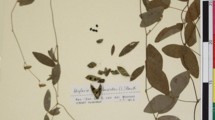Summary
The totora (also known as matara and merme),Scirpus californicus, is widely used in Ecuador and Peru for a number of purposes. Floats made from it are still found at L.ake San Pablo and Yaguarcocha in Ecuador and at Huanchaco and L.ake Titicaca in Peru. Totora mats of highland Ecuador are woven, whereas woven mats are rare in Peru where twining seems to be the common method. Although commonly known by the Spanish name esteras, the mats are sometimes referred to as petates, a Mexican name, which may have reached the Andes in pre-Conquest times. Totoras are also used to make fans and baskets, and as food for both man and animals, the former only in the area of Lake Titicaca. The totora may have been cultivated in prehistoric times. The extensive altitudinal distribution and the apparent lack of seed set in some highland lakes suggest that man may be implicated in its spread. The totora is definitely known to be cultivated in both Peru and Ecuador in recent times. The totora comprises two subspecies: subsp.californicus found in the highlands of Ecuador and in both highland and coastal sites in Peru, and subsp.Tatora, confined to the highlands of Peru. There may be some justification for considering the two as distinct species. Chromosome counts ofn = 32 and 34 are reported for subsp.catifornicus andn = 35 for subsp.Tatora. Plants of both subspecies were found to grow well in the greenhouses at Indiana University. The totora of Easter Island, previously regarded as a variety of subsp.californicus, was found to be virtually identical to American populations of the subspecies. Although Heyerdahi has claimed that the totora was introduced into Easter Island by Peruvians in prehistoric times, it is pointed out that birds are equally, or more likely, responsible for its introduction there.
Similar content being viewed by others
Literature Cited
Acosta, Joseph de. 1940. Historia Natural y Moral de las Indias, vol. 1. Fondo de Cultura Economica, Mexico, D. F.
Acosta-Solis, M. 1961. Los Bosques de Ecuador y sus Productos. Editorial Equador, Quito
Alcedo, Antonio de. 1967. Diccionario Geográfico de las Indias Occidentalis o América, in Biblioteca de Autores Espaçoles desde la Formacion del Lenguaje hasta Nuestros Dias. Madrid. (Originally published 1786–1789.)
Anonymous. 1669–1684. Archivo General de la Nación. Sección: Derecho Indígena. Cuaderno 140, hojas no. 193- Fol. 172. Lima, Peru.
Anonymous. 1692. Archivo General de la Nación. Sección: Derecho Indígena. Cuaderno 166- Fol. 55. 1654. Lima, Peru.
Beetle, Alan A. 1941. Studies in the genusScirpus L. III. The American species of the section Lacustres Clarke. Amer. Jour. Bot. 28: 691–700.
Cárdenas, Martí. 1969. Manual de Plantas Economicas de Bolivia. Imprenta Icthus, Cochabamba.
Cobo, P. Bernabé. 1890. Historia del Nuevo Mundo. Sevilla.
Cordero, Luis. 1950. Enumeración Botánica... de la Republica del Ecuador. Ed. 2. Afrondisio Aguado, Madrid.
Edwards, Clinton R. 1965. Aboriginal watercraft on the Pacific coast of South America. Ibero-Americana: 47.
Espinosa, Reinaldo. 1949. Estudios Botánicos en el sur del Ecuador. Vol. II. Editorial Universitaria, Loja.
Foster, George M. 1948. Empire’s Children: the People of Tzintzuntzan. Smithsonian Institution. Inst, of Social Anthrop., Publ. no. 6.
Heiser, C. B 1974. Totoras, taxonomy and Thor. Plant Science Bulletin 20: 22–26.
Hernandez, Francisco. 1942. Historia de las Plantas de Nueva Espaçna. Imprenta Universitaria. Mexico, D. F. (reprint)
Heyerdahl, Thor. 1952. American Indians in the Pacific. Glydendal Norsk Forlog, Oslo.
— 1971. The Ra Expeditions. Doubleday, Garden City, N.Y.
—and E. N. Ferdon Jr., (editors). 1961. Archaeology of Easter Island. Vol. 1. The School of American Research and the Museum of New Mexico. No. 24, part 1. Santa Fe, N.M.
Koyama, Tetsuo. 1963. The genusScirpus Linn., critical species of the section Pterolepis. Canad. Jour. Bot. 41: 1107–1131.
La Barre, Weston. 1948. The Aymara Indians of the Lake Titicaca plateau, Bolivia. Mem. 68. Amer. Anthropol. Assoc.
McBryde, Felix W. 1945. Cultural and historical geography of southwest Guatemala. Smithsonian Institution, Inst, of Soc. Anthrop., Publ. no. 4.
McIntyre, Loren. 1973. Lost empire of the Incas. Nat. Geog. Mag. 144: 729–786.
Parodi, Lorenzo R. 1933. Las balsas usadas par los aymaras en el lago Titicaca. Physis 11: 145–149.
Pérez de Barrados, José. 1951. Los Muiscas de la Conquista. Vol. 2. Consejo Superior de Investigaciones Cientificas.
Robinson, Scott R. 1966. The Indians and the tules, p. 57–80, in The Indians of Colta, E. Maynard (ed.). Cornell University, Ithaca, N.Y.
Sahagún, Bernardino de. 1938. Historia General de las Cosas de Nueva Espaça. Vol. 3. Edit. Pedro Robredo. Mexico, D. F.
Schuyler, Alfred E. 1976. Chromosome numbers of some eastern species ofScirpus. Bartonia 44: 27–31.
Villarroel, Fernando. 1975. Tres esteras al dia tras el esfuerzo del indigena p. 7. El Comercio (Quito), Feb. 10.
Yacovleff, E. andF. L. Herrera. 1934. El mundo vegetal de los antiguos peruanos. Rev. Museo Nac. Lima 3: 242–322.
Yanovsky, Elias. 1936. Food plants of the North American Indians. United States Department of Agriculture. Misc. Publ. No. 237.
Author information
Authors and Affiliations
Rights and permissions
About this article
Cite this article
Heiser, C. The Totora (Scirpus Californicus) in Ecuador and Peru. Econ Bot 32, 222–236 (1978). https://doi.org/10.1007/BF02864698
Received:
Accepted:
Issue Date:
DOI: https://doi.org/10.1007/BF02864698




